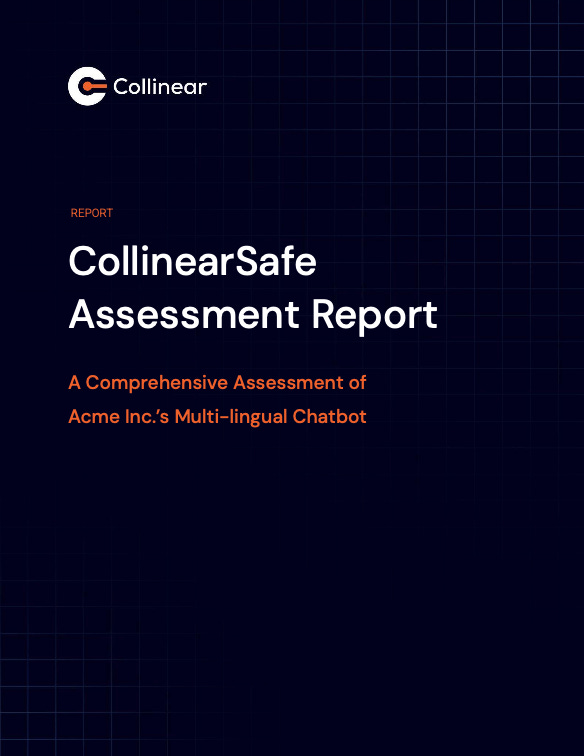The Limitations of AI Evaluations
Why Enterprises Need a New Approach
“AI is like the Wild West because we don’t really have good evaluation standards,”
AI is everywhere — it’s in production across enterprises, powering decision-making in high-stakes environments like finance, healthcare, and customer service. The McKinsey Global Institute (MGI) estimates that Gen AI could add between $200 to 340B in value annually across the global banking sector alone. But as companies race to deploy AI-driven solutions, a critical issue remains largely overlooked: AI evaluation methods are fundamentally broken.
For many organizations, evaluating AI means relying on static benchmarks and human feedback loops—a fragmented approach that fails to reflect the real-world complexities of enterprise AI performance.
At Collinear, we believe it’s time to move beyond AI evaluation and toward something much more valuable: AI improvement.
The Fundamental Flaws of Traditional AI Evaluation
AI evaluation frameworks—whether through human review, automated testing, or model-to-model comparisons—are not only limited but also create a false sense of confidence. Here’s why:
1. Current gen evals are static testing in a dynamic world
Imagine trying to measure the height of a sand dune in a windstorm. That's essentially what we're doing with current AI evaluation methods. Most evaluation frameworks rely on pre-defined test sets or benchmark datasets. While these can offer a snapshot of a model’s performance at a given time, they fail to account for real-world complexities:
AI models are constantly changing. A recent study by Harvard and MIT finds that 91% of ML models degrade over time. Fine-tuning, reinforcement learning, and continuous adaptation alter model behavior, rendering static evaluations obsolete.
Enterprises need more than "one-and-done" testing. Unlike traditional software, AI models require continuous monitoring and iterative improvements to remain effective in dynamic environments.
2. Benchmarking alone doesn't predict real-world performance
Goodhart's law states that when a metric becomes a target, it loses its value as a measure. Originally about monetary policy, it also applies to machine learning, where optimizing a proxy objective can lead to overfitting and misalignment with the true goal.
Many enterprises rely on academic benchmarks like MMLU, TruthfulQA, or BLEU scores to gauge performance. But these metrics are often mirages, creating false oases of confidence. Satya Nadella recently criticized the practice of citing benchmark scores as “nonsensical benchmark hacking” on Dwarkesh Patel’s podcast. Benchmarks miss the mark when applied to production AI:
They lack real-world context. AI that scores highly on a benchmark may still fail in real world business use cases due to domain or context-specific nuances.
Benchmarks are not a proxy for trust. They measure correlation, not causation—an AI model may “look good” on paper but still be unpredictable in real applications.
3. Human Feedback is expensive and inconsistent
Human feedback is often touted as the gold standard for AI evaluation, but it comes with significant downsides.
Subjectivity: Even the best-trained annotators and linguists introduce bias, leading to inconsistent results.
Scalability issues: Human evaluation is slow, expensive, and impractical at scale, especially for high-volume, enterprise-grade deployments.
The Shift from Evaluation to Improvement
At Collinear, we advocate for a shift away from passive AI evaluation and toward building an AI improvement flywheel. Rather than just diagnosing problems, enterprises should create a self-reinforcing cycle where insights from real-world performance drive iterative learning, better safety guardrails, and continuous refinement—ensuring AI models become more reliable, adaptive, and aligned with business needs over time.
Here’s how the future of AI quality assurance should look:
1. Continuous assessment instead of one-time evaluation
Rather than relying on outdated snapshots of AI performance, enterprises should assess AI in real time—analyzing how models behave in production and adapting based on actual user interactions.
AI monitoring tools should proactively detect performance degradation.
Risk exposure assessments should be built into enterprise workflows, not left as an afterthought.
2. Semantic evals that go beyond basic keyword checks
A major limitation of traditional AI evaluations is their inability to provide actionable next steps. AI judges should not just passively score outputs—they should:
Identify risks and failure modes before they impact business outcomes.
Offer precise remediation steps for AI model improvement.
Integrate seamlessly into enterprise AI pipelines for continuous feedback.
3. Moving from benchmarks to business impact
Instead of asking, “How does my AI perform on an MMLU?”, enterprises should be asking:
✅ Does this AI provide real business value?
✅ Is it continuously improving over time?
This requires AI improvement frameworks that go beyond conventional testing and instead prioritize real-world reliability, adaptability, and risk mitigation.
The Future of AI Performance: From Evaluation to Evolution
The AI landscape is evolving too quickly for static benchmarks and flawed evaluation methods to keep up. Enterprises that continue chasing leaderboard scores will find themselves left behind—while those that embrace real-time monitoring, intelligent AI judges, and business-driven metrics will build safer, more reliable AI.
At Collinear AI, we help enterprises move beyond AI evaluation and toward continuous improvement. Our tools integrate real-time AI monitoring, risk-aware performance tracking, and automated remediation to keep AI systems accurate, compliant, and business-ready.
🚀 The companies that embrace this shift will lead the next wave of AI innovation. The ones that don’t? They’ll be stuck gaming benchmarks while their competitors build AI that actually works.
Ready to build an AI improvement flywheel?
Take a look at one of our CollinearSafe assessment reports. Uncover AI model weaknesses through our proprietary CollinearSafe red-teaming. Comprehensive assessment delivered in only one business day.
Schedule a live demo or a consultation today to see how we help enterprises drive performance and quality improvement for their AI solutions.








